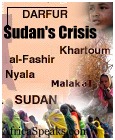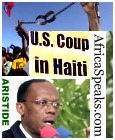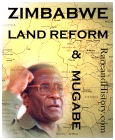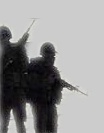 |






 AfricaSpeaks Weblog AfricaSpeaks Weblog
 Rootswomen Weblog Rootswomen Weblog
 Rootsie's Weblog Rootsie's Weblog
|
The Intifada is dead, long live the Intifada
Posted: Thursday, August 8, 2002
By Gabriel Ash, YellowTimes.org
The second Palestinian Intifada will be remembered above all for its gory character. The suicide attacks against civilians grabbed all the headlines. The second Intifada had many other aspects, including clashes with Israeli soldiers, non-violent resistance, and dogged Palestinian endurance of Israel's war against the civilian population, but the suicide attacks are its defining signature. This signature will leave deep scars in both Israeli and Palestinian societies for a long time.
One should not forget, however, while noting the moral black hole from which such actions emerge, that those who have condemned the suicide attacks while discounting or even defending Israel's far greater and far more enduring and systematic violence against civilians are themselves participating actors in the racist historical constellation that drove many Palestinians towards such terrible choices.
But now the second Intifada is almost over. We need to understand it as a historical event that happened in its context. Taking stock of its achievements and failures will also explain why it is coming to end and why it will be reborn.
On a psychological level, the second Intifada is the first time, since 1948, that Palestinians have escaped total and unilateral victimization. Despite the terrible toll that Israel's methods of collective punishment have taken, the second Intifada, at least relative to the past, achieved an unprecedented symmetry. For the first time, the homes and streets of central Israel became part of the battlefield, an experience that was the rule rather than the exception for Palestinians since 1948.
In that respect, the extreme violence against Israel was a reassertion of Palestinian existence. This is no doubt a major factor that must be understood in order to account for the strong public support for the Intifada.
One cannot make sense of the resistance without understanding the strategy of the power being resisted. Historically, the dominant strand of Zionism, Labor Zionism, strove, with respect to Palestinians, to achieve three objectives:
dominate a maximum of lands and resources taken from Palestinians,
repress the emergence of Palestinian national force that would challenge this domination, and
mask this domination and the forces used to protect it in order to maintain an image of a Western democratic and liberal society.
The 1967 conquest of the West Bank and Gaza complicated these tasks significantly by vastly increasing both the area of land and the number of Palestinians under direct Israeli rule. The subsequent history of the conflict consists of Israel's attempts to maintain the aforementioned three goals in the face of the new reality:
The peace with Egypt, signed in 1977, resulted from Isreal's strategic need to isolate the dirty war against the Palestinians from the larger Arab context, of which Egypt was the leading power. The move was successful, allowing Israel to invade Lebanon in 1982 without worrying about a Southern front. The invasion itself was a move to undermine the political pressure to recognize and negotiate with Palestinians over land.
A successful smear campaign against the PLO allowed Israel to convince the U.S. public, as well as its own, that Palestinian terror and commitment to the destruction of Israel made compromise over land impossible. The facts that a) Israeli terror claimed over ten times more civilian victims than the actions of the PLO, and b) that since 1974 the PLO gradually moved towards the international consensus favoring a two state solution with a Palestinian state on 22 percent of the original disputed land, were ignored.
The threat of Palestinian nationalism, in the form of the growing popularity of the PLO, had to be tackled in the territories at the same time. Israel thus created the "village leagues," a crude attempt to repress the population using nineteenth-century colonial tactics. The strategy assumed that Palestinians could be controlled by buying and empowering local "chieftains," who would take orders from Israel and force them on the population with the full power of state violence.
It didn't work. Palestinian passive resistance turned into the first Intifada in 1987. The first Intifada was a success. Israel moved to vigorous open repression exemplified in then Defense Minister Itzhak Rabin's order to IDF soldiers: "break their arms." However, the well televised repression undermined Israel's pretense of enlightenment. The Intifada convinced most Israelis that 19th-century style direct rule was unworkable. It also impressed on the international scene that the issue of Palestinian self-determination could no longer be avoided.
But the first Intifada was also a failure: it didn't produce liberation. Israel, nudged by the first Bush administration, responded with the "Oslo process," essentially an update of the methods of repression from 19th century colonialism to a 20th century model of Hidden Apartheid. In this Labor Zionist vision, Palestinians would get a weak, demilitarized statelet, totally dependent on Israel economically, and without control of vital resources, including land reserves, major roads, water, airspace, etc. Palestinian self-determination would be realized, and buried, in a Palestinian stamp.
The Hidden Apartheid model involved Israeli acceptance of a Palestinian state, on condition that this state, and all its resources, would be under total Israeli control. This was an effective apartheid model because its goal was to allow the dominators to keep the dominated legally and physically separate from "democratic" Israel, without relinquishing the power of the dominators over land and water resource. The model preserved the goals of Labor Zionism. It ceded, in theory at least, nothing of substance, while allowing Israel to regain the image of an enlightened state. The "hidden" aspect of the new Apartheid was so well hidden that many Israelis and Palestinians failed to understand it at the time.
To protect Israel's control over Palestinian land and water, a corrupt and brutal Palestinian leadership was needed, ready to repress all dissent vigorously, thus freeing Israel from having to tarnish its own image. Arafat, weakened by his support for Saddam Hussein in the Gulf War, was ready to play along. His organization was already corrupt, and to the extent that it wasn't, Israel was happy to tempt it and corrupt it further with large development funds secured from the U.S. Arafat took the bait.
It is likely that Arafat believed he could still turn things in his favor. He said so himself when he signaled that his adherence to the Oslo deal should not be taken for much. He hoped that American pressure would force Israel to make bigger concessions than it originally intended. That was a gross miscalculation. The U.S. fully supported the Hidden Apartheid model.
Arafat was confronted with the magnitude of his miscalculation at Camp David II, when Barak, with full U.S. support, asked him to sign off all Palestinian demands in return for the formal declaration of a Palestinian state according to the Hidden Apartheid model. The true nature of Barak's "generous" offer can be easily ascertained by looking at the maps.
However, Arafat's rejection of the Hidden Apartheid framework came too late. By 2000, the time of the Camp David II summit, his rule was so corrupt and despised that a majority of Palestinians saw him as a major part of the problem.
The second Intifada thus emerged as the grassroots Palestinian response to the double threat of external oppression and internal corruption. It was a revolt against the Hidden Apartheid model and against the PLO old leadership, the people who were loyal to Arafat and who staked their future on the collaboration with the Israeli domination.
Understanding this leads directly to the conclusion that the Intifada has reached its end.
True, Palestinian liberation is nowhere in sight. True, the extreme price paid by Palestinians, the crisis level economic destruction, the many killed and many more maimed, the traumatization of a whole generation of children, are undeniable. True, the Palestinian resistance has survived all Israeli attempts to eradicate it.
However, the Intifada has accomplished its historical mission. Both the Hidden Apartheid model of domination (at least in the Oslo incarnation) and Arafat's ability to act as Israel's appointed strongman, are things of the past.
This is the background for the disintegration of the dominant Zionism of the Labor party in Israel. The party is in its death grip - more and more senior members are leaving the sinking ship with every passing week. The cause of death is the collapse of the "Oslo" peace process. As a result of this collapse, the three goals of Labor Zionism are no longer achievable together, or at least, Israeli ideologues no longer know how to achieve them together.
The extreme right wing, the supporters of "transfer" and Apartheid, are ready to give up the third goal - Israel's image of a Western democracy - and to become an unapologetic Jewish racist state. That is, frighteningly, the most coherent and self-conscious movement in Israel. But it is still a minority view; many realize it is self destructive.
The possibility of acknowledging the Palestinian demand of true self-determination is made even more unpalatable, at least to the majority of Israelis, by the very memory of the recent violence, which evokes the extermination fears long cultivated by the Zionist leadership. It also smacks too much of defeat, and that too makes it unpalatable.
New ideas that emerged so far, such as "unilateral withdrawal," are largely acts of ideological desperation, last ditch attempts to pretend that the old colonial show can go on, somehow.
The Tanzim and Hamas leaders are correctly sensing that there is nothing to gain from continuing the killing. Not only does it now strengthen Sharon and the extreme right in Israel, but the violence also keeps Arafat afloat. (This is a notable irony. While Arafat was the main political victim of the Intifada, Israel kept accusing him of masterminding it. Now, having been marginalized, Arafat is finally the only one who has anything to gain from the continuation of the Intifada. But just as he did not have the ability to stop it then, he doesn't have the ability to make it continue now.)
Hence last week's ground-breaking understanding between Tanzim and Hamas, notably without Arafat in the picture, calling for the effective cessation of suicide attacks against Israeli civilians.
Israeli propaganda tried to portray that accord as insignificant, since it came from the field rather than from the leadership. (Again, how ironic: until last week, the same propagandists maintained that Arafat was not a partner of negotiations because he didn't control the field!)
As the bomb in the Hebrew University cafeteria shows, Israel still has the power to manipulate Hamas against ceasing the attacks. Hamas is caught up in its fear of appearing to have been defeated and probably also in a large dose of self-defeating pride. But that kind of tit-for-tat cannot last for long once the deep causes have evaporated.
Despite the setback caused by Israel's terror attack in Gaza and Hamas' retaliation, it is quite likely that the unilateral cessation of attacks on civilians will be revived soon - it is not based on starry eyed idealism, but rather on a correct reading of the diplomatic and political map.
The end of attacks on civilians has many appealing aspects beyond winning the Palestinians the moral high ground.
It will allow the Tanzim field commanders to sideline Arafat with U.S. help and consolidate a new, and hopefully less corrupt, leadership. Naturally, Sharon will try to prevent it, but his strong commitment to ousting Arafat will make it difficult.
A unilateral cease-fire will strengthen the marginalized peace camp in Israel (the real peace-camp, not the phony labor-meretz partnership).
Hamas too will have a good chance to transform its popularity into a seat at the negotiating table.
But let us not forget one thing: the mainstream leadership in Israel will not give up its goals of domination. On the contrary, the IDF will claim to have defeated the resistance with its brutal tactics, and right wing politicians will use that as evidence that no compromise is needed.
Phony peaceniks will surely come up again with new convoluted plans to continue the denial of Palestinian rights while appearing to grant them, and the U.S. government and media will gladly support them.
If nothing else, the next Palestinian elections will be the subject of much procedural innovation, as Israel and the U.S. try to prevent the election of Marwan Barghouti, Israel's most charismatic political prisoner.
The second Intifada is almost over. It succeeded. It failed. It was horrible.
It is not too soon to start thinking about the third Intifada.
[Gabriel Ash was born in Romania and grew up in Israel. He is an unabashed "opssimist." He writes his columns because the pen is sometimes mightier than the sword - and sometimes not. Gabriel lives in the United States.]
 Printer friendly version Printer friendly version
 Send page by E-Mail Send page by E-Mail
|








